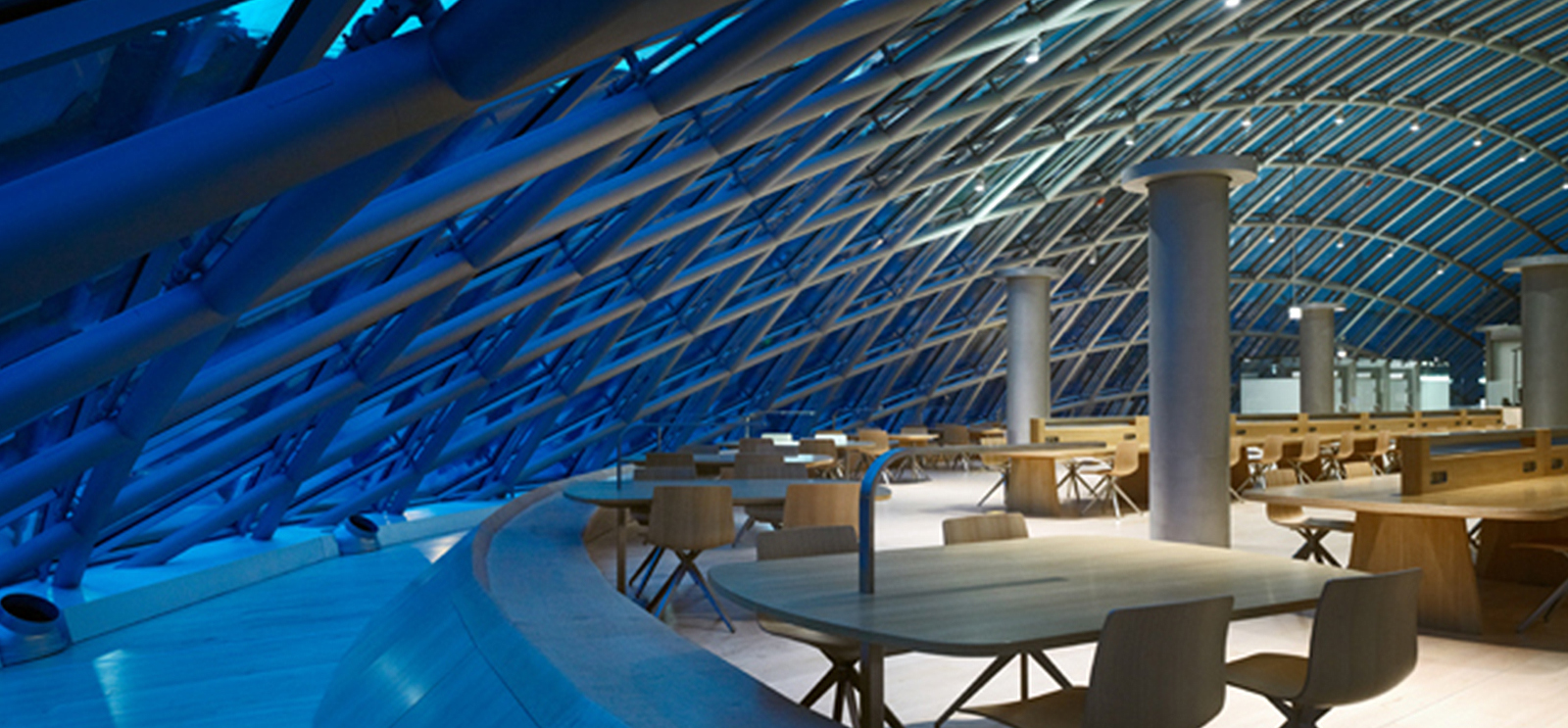
Cool hue: Mansueto's 691 glass panels have three layers, filter 98 percent of UV rays, and reject 73 percent of solar heat. (Photography by Nathan Kirkman)
… Reg Egg, Igloo: As quickly as students have dreamed up pet names for Mansueto, they've adopted the futuristic library as their own.
The critics have visited the Joe and Rika Mansueto Library, had their say, and left: the Chicago Tribune praised its "ingeniously conceived and largely well-executed design," and Wired hailed it as "the library of the future." By summer, organized tours for students and staff had given way to visits by prospective students and parents who wandered in and snapped photos. Jam-packed this past spring with students trying out the most popular study space on campus, the sunny reading room was now less than half full. Two months after the library opened its doors in May, the ordinary routines of daily life in Mansueto were taking shape.
The grand reading room and circulation service center occupy slightly more than half of the space under the Helmut Jahn–designed dome. In the northwest quarter sits the conservation laboratory, where Ann Lindsey, head of conservation at the University of Chicago Library, is busy flattening out maps. On work tables lie a pair of partially hand-drawn and -colored maps of Chicago Heights, Illinois, dating from 1906 and 1907. Inside the solvent room (a freestanding space under the dome with its own ventilation system), a map of the Chinese city Fuzhou, dating from between 1860 and 1911, sits on a suction table, where a vacuum gently holds the delicate paper in place while the conservators work. Lying nearby is a 1949 map of London that had been folded for so long that it broke along the paper's brittle creases. Lindsey and her two-person staff had pieced it back together, matching up every lane and alley, with Japanese kozo tissue and wheat-starch paste. A new backlit table made that job considerably easier. In fact, every aspect of their work has gotten easier with the move, Lindsey says. Their former quarters in the Regenstein were so cramped that it was difficult to work on more than one thing at once—to say nothing of spreading out four large maps simultaneously. Now, she says, they have "space for people, space for items, space for equipment"—including paper presses, a sink to wash and deacidify paper, and a freezer to halt water damage or kill insects that feed on books, such as silverfish or moths.
In the digitization laboratory next to conservation, a volume of Diderot's 18th-century Encyclopédie—one of the first encyclopedias—rests in a wooden cradle. The cradle, draped in cloth, supports large books while they're held open for photographing. A digital scanning back camera, mounted on a copy stand above the cradle, is set to take pictures of the book's illustration plates, adding to the Encyclopédie's online version produced by the Project for American and French Research on the Treasury of the French Language. Before the digitization group settled in Mansueto, it had been in temporary space over the past few years, explains Kathy Arthur, the library's head of digitization. The new space is more than twice as large and couldn't open soon enough: by July the digitization facilities were booked solid for the coming academic year.
The dome, its 691 unique glass panels, the reading room, circulation desk, and the preservation spaces are all just the tip of the iceberg. Mansueto's raison d'être is its high-density automated storage system. The racks occupy a five-story cavern below ground, with room for 3.5 million volumes. By the end of the summer, explains Jim Vaughan, assistant director for access and facilities services at the library, the automated storage system will be one-third full, with the remainder reserved for future transfers, to make shelf space in other campus libraries available for browsing future acquisitions.
Stairways and an elevator on the dome's perimeter lead down 55 feet to the building's bottom level, where roughly 70 College students have been hired to fill the automated storage system this summer. For eight hours a day, they load large journal runs into 24,000 bins and elephant folios into 1,200 racks that comprise the automated retrieval system—the largest, Vaughan says, in North America.
"We believe that having materials close by enhances their use and that storing them remotely will do the opposite," library director Judith Nadler told the University News Office this past spring. Placing them in the automated storage racks not only keeps them on campus (some had been in temporary storage in Indiana) but also frees up shelf space for materials more likely to benefit patrons while browsing.
With students loading bins and racks this summer, Vaughan notes, the basement will likely never be this busy again. Once the work is finished, a normal day will find the basement bereft of life; the environment will hover at 60 degrees and 30 percent relative humidity, and the spindly yellow robotic cranes and lifts will do their jobs in the dark.
Mansueto's capacity will let the library keep housing newly acquired works for another two decades. What happens after that is anyone's guess, considering how rapidly digital media is changing the world of publishing. But a little future proofing goes a long way: by accommodating books both electronic and paper, Chicago's library of the future is likely to retain that title for a long time.
